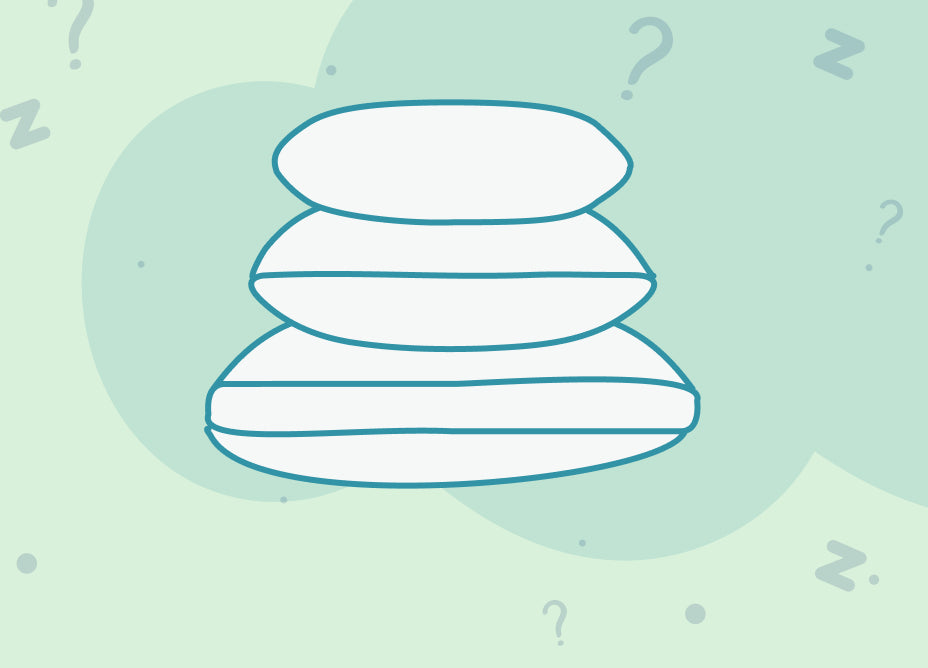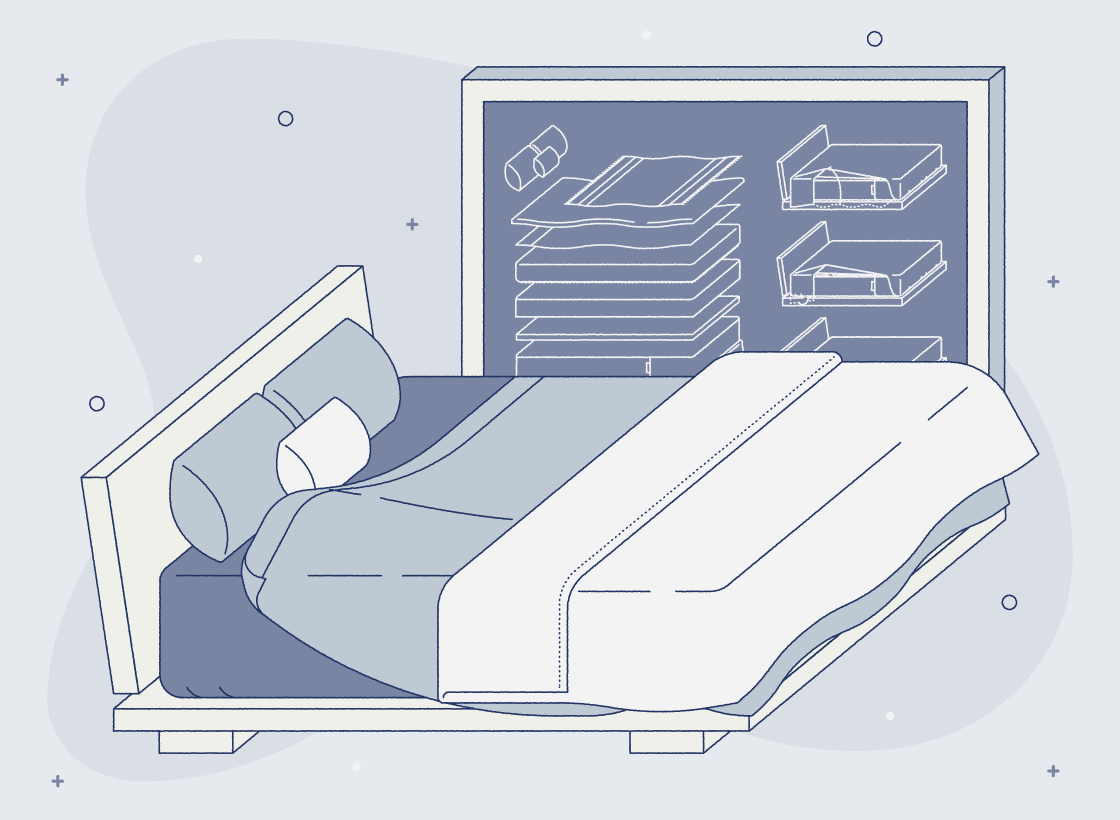Updated May 28, 2025
If you’re already experiencing trouble falling asleep, sagging on your side of the bed, and never seem to wake up feeling rested due to poor sleep, these are some obvious signs you need a new mattress. But don’t worry, a new, quality mattress will help increase sleep quality and give you a better night’s sleep. But how often should you replace your mattress?
Typically, most mattresses should be replaced every 7-10 years, but this number can vary depending on the mattress type you have.
Don’t wait any longer for a good night’s sleep. Get better sleep quality now. Read on to find out how often you should replace your mattress, based on the mattress type you have now.
Understanding the Lifespan of Different Mattress Types

So how often should you change your older mattress for a mattress replacement? This largely comes down to what your old mattress is made of.1
Latex Mattresses
Mattresses made up of latex layers have an incredibly long life and can retain their shape for up to 15 years. Natural latex mattresses are among the best options for those concerned about sleeping hot, thanks to their breathability and temperature-regulating properties.1 Synthetic latex and certain mattress designs may sleep warmer1 depending on specific construction and materials, but overall, latex sleeps cooler than other foams.
The mattress lifespan or longevity of latex mattresses also depends on semi-frequent rotation, 1-2 times a year, to prevent mattress sagging and dents.
Memory Foam Mattresses
What is memory foam, exactly? These body-conforming mattresses deliver deep compression support and pinpoint pressure relief, making them extremely popular to all kinds of sleepers for a good night’s sleep. People with any type of sleeping position tend to love foam, from a stomach sleeper to someone who prefers a different sleeping position like sleeping on their side.
Not only are these mattresses comfy, but they also offer significant durability making for a quality mattress.
Foam mattresses can last up to ten years if you treat them well. That means rotating them 180 degrees every 3-6 months so you’re not sleeping in the same spot for too long, and ensuring those foam cells bounce back.
Does a memory foam mattress sound right for you? Casper offers an amazing all-foam mattress for your next mattress replacement or upgrade:
- The One – A straightforward, medium-firm all-foam bed designed for support, pressure relief, and affordability. It is best suited for back and stomach sleepers or couples seeking motion isolation at a budget-friendly price.
Innerspring mattresses rely on, well, springs, for support, which can wear down more quickly than other mattress types depending on the quality of springs or coil-based system it uses, leading to a shorter lifespan.2 The Sleep Foundation reports an average lifespan of 5.5 to 6.5 years for innerspring mattresses.3
On the bright side, flipping over and rotating innerspring mattresses 180 degrees every 6-12 months can increase their longevity. You can tell your innerspring mattress has lived out its purpose when there’s excessive sagging, and you start to feel the coils poke through.
Hybrid Mattresses
These beds combine the best of all worlds, blending different materials for support, and often using the bouncy foundation of an innerspring base with a comforting memory foam mattress topper.
- Casper Dream – Meet your back’s new best friend. The Dream Hybrid blends pressure-relieving foams with responsive springs, giving you just the right balance of comfort and support. It’s designed to align your spine, reduce tossing, and help you wake up feeling like you actually slept. No fluff, just the stuff that dreams (and great mornings) are made of.
- Casper Dream Max – Sleep like it’s a science—because it is. The Dream Max is packed with precision-cut foam and encased coils for maximum ergonomic support. If you’re tired of waking up sore, this plush hybrid is your fix. It’s our most supportive mattress ever—engineered for deep sleep and even deeper sighs of relief. Sleep perfection took 10 years. You just get to enjoy it.
- Casper Snow – You shouldn’t have to choose between cozy and cool. With Snow Technology, this hybrid mattress keeps you 5° cooler all night, using heat-wicking bands and breathable foams that regulate your temperature like a boss. Zoned Support targets the places that need it most, so you sleep supported, aligned, and uninterrupted—even when summer turns your bedroom into a sauna.
- Casper Snow Max – Maximum cooling meets maximum support. The Snow Max is the heavyweight champ of Casper cooling, loaded with 6 HeatDelete™ Bands, Phase Change Material, and Zoned Support Max. It cradles you where you need it and cools you when you don’t want to sweat it. Perfect for hot sleepers, side sleepers, or anyone ready to stop losing sleep over their mattress.
How often should you get a new mattress when it comes to Casper hybrid mattresses? Luxurious Casper hybrid mattresses last 8-10 years and like our other beds, we recommend rotating them 180 degrees every 3-6 months to keep them performing their best. Casper mattresses should only be rotated, never flipped. Our hybrids provide you with the amazing combination of comfort and price that will keep your body happy, and your brain worry-free.
9 Signs You Need A New Mattress
How do you know when you need a new mattress? It can be hard to part with something you’ve had for a long time, that you’ve come to rely on. Your old mattress has been there to let you sleep in on weekends, comfort you when you’re sick, and give you a break after a long day.
But are you really getting the sleep you need and deserve—or have you just gotten used to the sleep you’re getting?
It’s not easy to say goodbye to mattresses, but better sleep is an important investment. A bad mattress or even an old mattress is a huge reason why people get poor sleep versus a good night’s sleep. Read on to discover some telltale signs that you need a new mattress.
#1 It’s Been 5-10 Years or More
How long do mattresses last anyways? Mattresses don’t come with an expiration date, but age should be one of the first things you consider when deciding to replace your mattress.
Though you may want to sleep in your current mattress forever, think of the wear and tear it goes through— your nightly tossing and turning, sweating, weight gain or loss, the addition of a child, pet, or partner. Not to mention normal atmospheric effects, including:
- Humidity
- Temperature flux
- Dust
Generally, after 5 – 10 years of sleep or more depending on your mattress type, it’s definitely time to replace that bed and let Casper refresh your sleeping space. The right mattress will help with getting more restful sleep and better sleep quality.
#2 Your Mattress Sags
Check out your mattress carefully when you’re changing your sheets and washing your mattress cover. Does it look even all the way across? Mattresses can begin to sag in certain places over time, especially if you tend to sleep in one spot on the bed. Even an inch or two of sagging can wreak havoc on your spine and prevent a healthy night’s sleep. You can always look into tips on how to fix a sagging mattress, but eventually, an upgrade might be the smartest choice.
#3 Your Mattress Has Other Visible Signs of Wear and Tear
Beyond sagging, there are other clues that your mattress has seen better days. Look for frayed seams, torn fabric, visible lumps, deep impressions, or even small rips. These physical signs show that the materials inside the mattress are breaking down—and if the outside looks worn, you can bet the inside is past its prime too.
#4 You Don’t Wake Up Feeling Rested
Night after night, you’ve got your sleeping routine down. You eat a filling dinner, wash your face, maybe wind down with a cup of tea or a book, then drift off to dreamland. But no matter how long you sleep, you don’t feel refreshed when you wake up.
This could be a sign your mattress isn’t delivering that deep sleep your body needs each night to perform its best the next day.
#5 Your Mattress is Noisy
Is your mattress starting to sound more like your dog’s favorite toy? Squeaking is a sign that the springs in your mattress are starting to break down and are becoming less supportive, less comfortable, and less, well, springy.4
Before pinning the noise on your mattress, check your box spring or bed foundation first. These are susceptible to some erosion as well.
#6 You Feel Achy
You slip into bed to rest your body and mind. To alleviate aches and pains sustained throughout the day—not to gain new ones. Unless you’re working out strenuously on a daily basis or have a job that demands a lot of heavy lifting, you shouldn’t be waking up clutching your back or feeling unexpected pain in your body.
This could be a sign that your mattress is no longer supporting you correctly. But it can help to take a look at the material of your mattress:
- If you have a memory foam mattress, it may not bounce back to its original shape as intended and no longer conforms to your body shape.
- If you have another mattress type like latex, hybrid, or innerspring mattress, look out for lumps, bumps, and “hammocking,” where you feel like you roll to the center of your mattress when you lay down.
#7 Your Allergies Are Flaring Up
If you start to feel sniffles coming on at night and in the morning, your older mattress could be the cause. Mattresses can collect a lot of dust and pet dander, and become a home for dust mites. If there’s enough moisture in the air, your mattress can even harbor mold and mildew.
Waterbeds and mattresses made of infused memory foam or latex tend to be resistant to this kind of buildup.5,6,7, But in any other case, make sure you’re using and washing a mattress cover that protects against dust, bed bugs, and sweat to prevent bedroom allergies.
#8 You Have Trouble Sleeping
Do you find yourself tossing and turning all night? Are you sleeping too hot or too cold? Do you feel that you just can’t find the right position, or wake up in the middle of the night? These could all be signs that it’s time for a new mattress.
Don’t let yourself slowly become accustomed to a lackluster sleep. In fact, you should be treating yourself to the luxurious technology Casper offers.
#9 Your Mattress Smells
Over time, mattresses can absorb moisture, odors, and bacteria from daily use. If you notice a persistent musty smell, even after cleaning your bedding, it’s a strong indicator that your mattress materials have broken down inside. An unpleasant odor is not only disruptive to your sleep environment but could also point to mold growth—making mattress replacement a must for your health and comfort.
Factors Affecting Mattress Lifespan
Not all mattresses age the same way. Everything from how a mattress is made to how you care for it can impact how long it stays supportive, comfortable, and in great shape. Here are a few key factors that influence mattress longevity:
Materials Matter
The type of materials used in your mattress plays a major role in how long it will last. Natural latex typically lasts the longest, followed by high-quality memory foam and hybrid designs. Innerspring mattresses, while supportive at first, can wear out more quickly depending on the quality of the bed’s springs, coil compression and material breakdown.2
Maintenance and Care
How you care for your mattress can add years to its life. Regularly rotating your mattress, using a high-quality mattress protector, and keeping it clean from dust and spills can help preserve the integrity of the materials. Neglecting basic care may cause even the best mattresses to wear out prematurely.
Sleep Habits and Use
The way you sleep—and how often—also affects your mattress's durability. Heavier sleepers, couples, or anyone who sleeps in the same spot every night may notice more sagging or wear over time. Guest beds or lightly used mattresses tend to last longer simply because they see less nightly pressure and movement.
How To Extend Your Mattress’s Lifespan
A little extra care goes a long way when it comes to keeping your mattress in top shape. Remember these simple habits to help protect your investment and enjoy years of better sleep.
Use a Mattress Protector
When you compare your everyday fitted sheet vs mattress protectors and covers, you’ll find that the latter options shield your bed from spills, sweat, dust, and allergens—all things that can wear down materials faster. It’s an easy, low-cost way to keep your mattress clean, fresh, and performing at its best for longer.
Invest in the Right Foundation
Using a supportive, high-quality mattress foundation or bed frame helps evenly distribute weight across the mattress. A sagging or unsupportive base can cause premature wear and tear, so always pair your mattress with the right foundation designed to support its structure.
Regular Rotation and Flipping
We can’t emphasize it enough — rotating your mattress every few months helps prevent deep body impressions and uneven wear. If your mattress is double-sided (Casper mattresses are not), flipping it can double its usable life by giving each side a chance to recover. So, how often should you rotate your mattress? It’s best to judge by type and check your mattress care guide to know what’s recommended. At Casper, we recommend rotating your mattress every 3-6 months. Never flip a Casper mattress, only rotate!
Investing in a Long-Lasting Mattress: Casper's Top Picks
When it’s time to upgrade, choosing a mattress built for durability and comfort makes all the difference. Casper’s lineup of mattresses is designed to deliver years of dreamy sleep with innovative support and premium materials that stand the test of time.
Mattresses That Last
For the best combination of quality and longevity, look to Casper for mattresses and pillows. Whether you’re looking to align your spine or fall into a plush cradle of comfort, you can rest easy knowing Casper has your back.
Experience true rest with Casper. Your body will thank you.
Sources:
- Plush Beds. Do Latex Mattresses Sleep Hot? Exploring Comfort & Temperature. https://www.plushbeds.com/blogs/green-sleep/are-latex-mattresses-temperature-neutral-sleep-comfortably-year-round
- Tom’s Guide. What is an innerspring mattress and are they any good? | Tom's Guide. https://www.tomsguide.com/reference/what-is-an-innerspring-mattress
- Sleep Foundation. How Long Should A Mattress Last? | Sleep Foundation. https://www.sleepfoundation.org/mattress-information/how-long-should-a-mattress-last
- Healthline. How Often Should You Change Your Mattress? Plus Why It Matters. https://www.healthline.com/health/when-to-change-mattress#how-you-know
- Waterbed Bargains. Why Waterbeds Are the Most Hygienic Sleeping Option - Waterbed Bargains. https://waterbedbargains.com/blog/why-waterbeds-are-the-most-hygienic-sleeping-option/
- Latex for Less. Why Latex Mattresses are Mold and Mildew Resistant | Latex For Less. https://www.latexforless.com/blogs/latex-for-less-blog/why-latex-mattresses-are-mold-and-mildew-resistant
- Tom’s Guide. Can you buy a mattress that naturally prevents mold? Yes — here’s what to look for | Tom's Guide. https://www.tomsguide.com/wellness/mattresses/can-you-buy-a-mattress-that-naturally-prevents-mold-yes-heres-what-to-look-for











